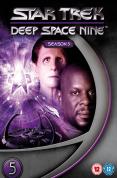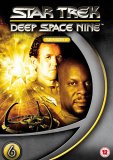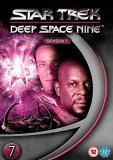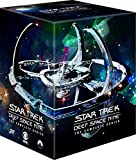 Star Trek - Deep Space 9 - Series 5 | DVD | (30/04/2007)
from £N/A
| Saving you £N/A (N/A%)
| RRP
Star Trek - Deep Space 9 - Series 5 | DVD | (30/04/2007)
from £N/A
| Saving you £N/A (N/A%)
| RRP The third Star Trek series is led by Benjamin Sisko commander of the space station Deep Space Nine who discovers the first known stable wormhole a virtual shortcut through space that leads from the Alpha Quadrant to the Gamma Quadrant on the other side of the galaxy. The Gamma Quadrant is governed by the Dominion a group led by the Changelings - an group of shapeshifters which counts DS9 crew member Odo (Rene Auberjonois) among its numbers. The Dominion has become a violent force in the galaxy and Deep Space Nine and its crew has become the only home in upholding the way of life established by the Federation. Episodes Comprise: 1. Apocalypse Rising 2. The Ship 3. Looking For par'Mach In All The Wrong Places 4. ...Nor The Battle Too Strong 5. The Assignment 6. Trials And Tribble-ations 7. Let He Who Is Without Sin... 8. Things Past 9. The Ascent 10. Rapture 11. The Darkness And The Light 12. The Begotten 13. For The Uniform 14. In Purgatory's Shadow 15. By Inferno's Light 16. Doctor Bashir I Presume? 17. A Simple Investigation 18. Business As Usual 19. Ties Of Blood And Water 20. Ferengi Love Songs 21. Soldiers Of The Empire 22. Children Of Time 23. Blaze Of Glory 24. Empok Nor 25. In The Cards
 Star Trek - Deep Space 9 - Series 6 | DVD | (30/04/2007)
from £N/A
| Saving you £N/A (N/A%)
| RRP
Star Trek - Deep Space 9 - Series 6 | DVD | (30/04/2007)
from £N/A
| Saving you £N/A (N/A%)
| RRP The third Star Trek series is led by Benjamin Sisko commander of the space station Deep Space Nine who discovers the first known stable wormhole a virtual shortcut through space that leads from the Alpha Quadrant to the Gamma Quadrant on the other side of the galaxy. The Gamma Quadrant is governed by the Dominion a group led by the Changelings - an group of shapeshifters which counts DS9 crew member Odo (Rene Auberjonois) among its numbers. The Dominion has become a violent force in the galaxy and Deep Space Nine and its crew has become the only home in upholding the way of life established by the Federation. Episodes Comprise: 1. A Time To Stand 2. Rocks And Shoals 3. Sons And Daughters 4. Behind The Lines 5. Favor The Bold 6. Sacrifice Of Angels 7. You Are Cordially Invited... 8. Resurrection 9. Statistical Probabilities 10. The Magnificent Ferengi 11. Waltz 12. Who Mourns for Morn? 13. Far Beyond The Stars 14. One Little Ship 15. Honour Among Thieves 16. Change Of Heart 17. Wrongs Darker Than Death Or Night 18. Inquisition 19. In The Pale Moonlight 20. His Way 21. The Reckoning 22. Valiant 23. Profit And Lace 24. Time's Orphan 25. The Sound Of Her Voice 26. Tears Of The Prophets
 Star Trek - Deep Space 9 - Series 7 | DVD | (30/04/2007)
from £N/A
| Saving you £N/A (N/A%)
| RRP
Star Trek - Deep Space 9 - Series 7 | DVD | (30/04/2007)
from £N/A
| Saving you £N/A (N/A%)
| RRP The third Star Trek series is led by Benjamin Sisko commander of the space station Deep Space Nine who discovers the first known stable wormhole a virtual shortcut through space that leads from the Alpha Quadrant to the Gamma Quadrant on the other side of the galaxy. The Gamma Quadrant is governed by the Dominion a group led by the Changelings - an group of shapeshifters which counts DS9 crew member Odo (Rene Auberjonois) among its numbers. The Dominion has become a violent force in the galaxy and Deep Space Nine and its crew has become the only home in upholding the way of life established by the Federation. Episodes Comprise: 1. Image In The Sand 2. Shadows And Symbols 3. Afterimage 4. Take Me Out To The Holo-Suite 5. Chrysalis 6. Treachery Faith And The Great River 7. Once More Unto The Breach 8. The Siege Of AR-558 9. Covenant 10. It's Only A Paper Moon 11. Prodigal Daughter 12. The Emperor's New Cloak 13. Field Of Fire 14. Chimera 15. Badda-Bing Badda-Bang 16. Inter Arma Enim Silent Leges 17. Penumbra 18. 'Til Death Do Us Part 19. Strange Bedfellows 20. The Changing Face Of Evil 21. When It Rains... 22. Tacking Into The Wind 23. Extreme Measures 24. The Dogs Of War 25. What You Leave Behind - Part 1 26. What You Leave Behind - Part 2
![Star Trek: Deep Space Nine - Season 2 [1995]](/pictures/1029194.jpg) Star Trek: Deep Space Nine - Season 2 | DVD | (28/04/2003)
from £N/A
| Saving you £N/A (N/A%)
| RRP
Star Trek: Deep Space Nine - Season 2 | DVD | (28/04/2003)
from £N/A
| Saving you £N/A (N/A%)
| RRP The second series of Star Trek: Deep Space Nine must have caused mixed feelings for those involved. There was a sense of optimism behind the scenes that stemmed from having gained a loyal following--made up of plenty of new fans--in its relatively short first year. The show had genuinely succeeded in being different from its predecessors. Better still, The Next Generation would be bowing out gracefully halfway through this year. So it was that, with several more series guaranteed, the writers changed tack from standalone tales and into long-running story arcs. This was immediately evident in the format-testing three-part opening. Through the actions of Kira and her old pals, we saw that the Bajorans would only ever work toward their own agenda, whereas the Cardassians easily switched sides to suit their various agendas. The Federation was hardly innocent of political machinations either, especially with the discovery of the Maquis terrorists a few episodes later. This three-way dynamic would underpin the entire run of the show. Expanding upon it was the handover of the Klingon saga from The Original Series and TNG, in which old warhorses Kor, Kang and Koloth first appeared. That left the Ferengi to maintain an element of fun with their Rules of Acquisition (Number 112: "Never have sex with the boss's sister"), exploration of their sexist culture and, naturally, through everything touched by the scene-stealing Quark (who was rewarded with a cameo for his real life wife). What seemed like standalone stories--Odo meeting his mentor, a trip into The Original Series' parallel universe and the culminating encounter with some super-soldiers (the Jem'Hadar)--later turned out to be more optimistic seed-sowing. Unfortunately, this second series also began with some concern about a competitor franchise, which started at exactly the same time as TNG ended. The impact of Babylon 5 on DS9 and TV SF in general by the end of the year could never have been envisioned at the start. --Paul Tonks
![Star Trek: Deep Space Nine - Season 4 [1995]](/pictures/1029163.jpg) Star Trek: Deep Space Nine - Season 4 | DVD | (25/08/2003)
from £N/A
| Saving you £N/A (N/A%)
| RRP
Star Trek: Deep Space Nine - Season 4 | DVD | (25/08/2003)
from £N/A
| Saving you £N/A (N/A%)
| RRP The fourth series of Deep Space Nine can be summed up in one word: Klingons! The show's producers apparently felt beset from all sides. Babylon 5 was a huge hit, as was Star Trek: Voyager, the flagship of new channel UPN. Stepping up DS9's action quotient seemed to be the answer. Time would tell, however, whether doing so via Trek's tried-and-tested former bad guys was the best solution. Opening with a special two-hour extravaganza, the new year was immediately unfamiliar. Dennis McCarthy's original theme--despite winning an Emmy--was deemed too subdued. As its upbeat new rendition kicked off, the station was seen in battle and swarming with activity. Moments later, we met old/new crewmember Worf, whose sudden appearance was the result of a brewing invasive strategy by the Klingons. This initiated the first of many loyalty shifts, as the Cardassians became the victims. With plenty of re-appearances by Gowron, Kor and Kurn, it was clear that an ongoing space opera was being crafted. Dukat revealed a tragedy-ridden daughter; Odo's relationship with his people (and Kira) became increasingly melancholy; and even the Jem'Hadar foot soldiers were given a sympathetic angle by their drug addiction. Adding to the layers of ambiguity about Earth's (read: the Producers') position over being at war, was the "outing" of Eddington and Sisko's girlfriend as rebel activists. Lest we forget the homely/spiritual side of the Captain, time was spent with a future version of Jake, with his father (Brock Peters), and on the nature of his role as "The Emissary". Avery Brooks worked behind the camera a couple of times, but this year the surprise was LeVar Burton directing five shows. There was still time for comedy: the Ferengi warped back to Roswell in 1947 and Bashir played at James Bond. But the year will be recalled predominately for its violence. One of the episodes Burton directed had its fight scenes drastically cut, while the series as a whole won an Emmy for its space battle effects. On the DVD: Deep Space Nine, Series 4 contains more than two hours of extra features. Although they might all have been better compiled into one long documentary, the sections devoted to Aliens, Production Design and Artwork are, nevertheless, nicely contained. "Charting New Territory" is a 20-minute featurette on all the big changes attempted this year: Worf's introduction, arming the station and being daring with stand-alone episodes. There's also a terrific and candid dossier on Michael Dorn (Worf), ten mini-cameo cast tales, four seasons' worth of episode introductions, and a well-stocked Photo Gallery. All this can be found on the set's seventh disc; there's also the fourth CD-ROM disc, which allows you to build your own station at home. --Paul Tonks END
![Star Trek: Deep Space Nine - Season 3 [1995]](/pictures/1029178.jpg) Star Trek: Deep Space Nine - Season 3 | DVD | (23/06/2003)
from £N/A
| Saving you £N/A (N/A%)
| RRP
Star Trek: Deep Space Nine - Season 3 | DVD | (23/06/2003)
from £N/A
| Saving you £N/A (N/A%)
| RRP Deep Space Nine's third series begins eventfully, with Sisko promoted to captain and being gifted a prototype warship equipped with a cloaking device, while Odo learns where he came from. In the two-part opening tale, this clever gambit is played to hook viewers into the idea of DS9 becoming an ongoing mystery/conflict show. Why the sudden intense format tweaking? Mostly this was to ensure the show continued to thrive when a really rather greedy production hierarchy fast-tracked Voyager onto the air mid-season (cue unnecessary crossover episode with Tuvok). Of greater concern was ratings thief Babylon 5, which played its counter-Trek cards at precisely the right time. Fortunately the result (initially at least) was a genuine boost for DS9. Cast members seemed to have hit their stride and played off one another more assuredly than before. For example, Odo's character took several additional interesting twists, especially in his relationship with Kira. Rene Auberjonois had a very good year, directing two episodes to boot. Avery Brooks had begun this trend with the previous year's penultimate show. The real surprise was seeing Jonathan Frakes's name working behind the camera on three occasions, because he also appeared on screen in his alternate rogue Riker role, when Thomas dramatically steals the Defiant. Other welcome cameos that aided the feeling of casual camaraderie included the return of Lwaxana Troi, as well as first appearances by Quark's Mum, the spooky Founder Leader, the lovely Leeta and the sneaky Eddington. Clint Howard--a cult Trek figure--was briefly welcomed back, and with the many faces of Jeffrey Combs another was born. Stories progressed the complicated Bajoran/Cardassian healing process, while simultaneously brewing potential conflicts far worse than the behind-the-scenes ratings war. --Paul Tonks
 Star Trek: Deep Space Nine: The Complete Series | DVD | (07/02/2017)
from £39.99
| Saving you £N/A (N/A%)
| RRP
Star Trek: Deep Space Nine: The Complete Series | DVD | (07/02/2017)
from £39.99
| Saving you £N/A (N/A%)
| RRP ![Star Trek: Deep Space Nine - Season 6 [1995]](/pictures/1029131.jpg) Star Trek: Deep Space Nine - Season 6 | DVD | (08/12/2003)
from £N/A
| Saving you £N/A (N/A%)
| RRP
Star Trek: Deep Space Nine - Season 6 | DVD | (08/12/2003)
from £N/A
| Saving you £N/A (N/A%)
| RRP Deep Space Nine's sixth series began ambitiously with a six-part story arc devoted to the Dominion War. This was a brave move in many ways, but a sensible one too. Whereas other SF shows wouldn't commit to showing the impact of war (Babylon 5), here there were numerous visible sacrifices. Characters were frequently kidnapped and held prisoner, allowing screen time for other members of the ever-growing cast (at its peak there were as many as 18 individuals with speaking roles per episode). This year also introduced the idea of Starfleet Intelligence and its sinister Section 31; alliances were built only to crumble almost immediately; Sisko led a suicide mission and at long last his destiny as the Emissary took a serious turn. Amid all this sturm und drang the writers felt it necessary to inject some levity. In fact, there was so much comedic sidetracking this year it actually seemed sometimes as if they were afraid of the series dark tone. Witness: Quark undergoing a temporary sex change, leading a Magnificent Seven-style band of Ferengi (with a cameo from Iggy Pop), Morn's non-speaking character being sorely missed, the blend of Troi and Guinan into 60's crooner Vic Fontaine and, in one fan favourite episode ("Far Beyond the Stars"), Sisko having visions of himself and the crew as 1950s staff writers on pulp magazine Incredible Tales. There were also cute reconciliations amongst Worf's extended family (leading to Trek's first cast wedding), and even the revelation of Bashir's genetically enhanced origins quickly became a subject for easy jokes. Any of these events would have been satisfactorily cute if the war had ended and the show had moved on. But confusing the viewer, every so often the battle would be rejoined mid-episode. The clinching proof that no grand design was really at work was in the sudden and brutal dispatch of Dax. Actress Terry Farrell gave sufficient forewarning of having had enough of the show, but specifically asked not to be killed off. Despite all the jarring humour scattered about after the strong opening, the show seemed unable to avoid reverting to shock tactics for its finale. All of which hardly made the promised final year seem a particularly enticing prospect. --Paul Tonks
![Star Trek: Deep Space Nine - Season 7 [1995]](/pictures/1029129.jpg) Star Trek: Deep Space Nine - Season 7 | DVD | (22/12/2003)
from £N/A
| Saving you £N/A (N/A%)
| RRP
Star Trek: Deep Space Nine - Season 7 | DVD | (22/12/2003)
from £N/A
| Saving you £N/A (N/A%)
| RRP The seventh and final series of Deep Space Nine came down to loose ends, tying some existing ones together and allowing others to unravel. Symptomatic of the unwillingness to let DS9 go was the immediate arrival of a replacement Dax, though poor Nichole deBoer as Ezri Dax had to have known she'd already missed the boat. Her appearance encouraged last-minute romances to blossom, with Bashir finally getting some action, Odo finally getting together with Kira and Sisko finally proposing to Kassidy. Another contributing cute factor were numerous trips to the Holosuite wherein the all-knowing Vic Fontaine dished out philosophical advice. That was when the crew weren't in there to play baseball against the Vulcans or when Nog wasn't commiserating about the loss of a leg. Oh yes, and don't forget the war! There was an early announcement that the show would attempt a 10-part resolution to the Dominion War, but viewers could be forgiven for forgetting all about it with so much sentimental distraction. When the horrors of war did resurface, they at least injected a few surprises into the mix. Odo and his ambiguously "evil" Founders were hit with a melting disease, prompting a backstabbing race for the power of developing and owning a cure. The original baddie Cardassians finally settled on the Federation's side. Contrary to these interesting twists, however, were the unexpected turns taken by matters relating to Sisko's spiritual destiny. Suddenly the mystery of the wormhole and an entire religious belief system was reduced to the problem of translating correctly the words of a sacred book. The struggle to join with some evil aliens significantly diluted the attempt at resolving what had begun seven years before in the show's pilot episode. Ultimately, Sisko's destiny, as with all those who'd followed him to the open-ended climax, was to be decided elsewhere. In a move that was either bold and daring--or possibly born of desperation for not having thought things through properly--the show's storylines were to be continued in a series of spin-off books. --Paul Tonks
![Star Trek: Deep Space Nine - Season 5 [1995]](/pictures/1029140.jpg) Star Trek: Deep Space Nine - Season 5 | DVD | (27/10/2003)
from £N/A
| Saving you £N/A (N/A%)
| RRP
Star Trek: Deep Space Nine - Season 5 | DVD | (27/10/2003)
from £N/A
| Saving you £N/A (N/A%)
| RRP Deep Space Nine's fifth series was a turning point from which there was no going back. Character and information overload took over, and the complicated twists and turns in the build up to war either hooked viewers securely, or sent them away with a headache. The Klingon faction instigated by Worf's arrival was occasionally played for laughs, but mostly their hard-headed personalities made all efforts at diplomacy moot. In the opening episode a chilling possibility is proposed as to why might be: have the Changelings infiltrated already and replaced key personnel? Some fans saw this as a flawed X-Files-style development. Nevertheless it sowed a seed of insidious suspicion from here on, affecting all the principal casts' relationship with one another, even allowing Odo and Quark an opportunity to confess a degree of friendship. Expanding on the new theme of duplication, the crew also made numerous trips to their Mirror Universe counterparts. As well as new uniforms and the milestone 100th episode, Nana Visitor and Alexander Siddig comically got to disguise the arrival of their child during filming. More laughs came from the fan favourite "Trials and Tribble-ations" with CG allowing Sisko and crew to interact with Kirk and a cameo from Leonard Nimoy. Avery Brooks began taking a backseat as of this year, partly a result of the now-overcrowded cast. Although Sisko's destiny would be foreshadowed by his first vision and the introduction of the Pah-wraiths, the Captain was in an increasingly sulky mood. Brooks only directed one episode, allowing room for regulars LeVar Burton and Rene Auberjonois to do more behind the camera. Joining them were Alexander Siddig, Michael Dorn and even Andrew Robinson. Available space started to seem hardly deep enough. --Paul Tonks
![Star Trek: Deep Space Nine - Season 1 [1995]](/pictures/1029211.jpg) Star Trek: Deep Space Nine - Season 1 | DVD | (24/03/2003)
from £N/A
| Saving you £N/A (N/A%)
| RRP
Star Trek: Deep Space Nine - Season 1 | DVD | (24/03/2003)
from £N/A
| Saving you £N/A (N/A%)
| RRP Of all the spin-off TV incarnations of Star Trek, Deep Space Nine had the hardest job persuading an audience to watch. By all accounts, Gene Roddenberry had concerns about the idea before his death in 1991. It took two more years to develop, and when it finally aired in 1993 reasons for that concern were evident right away. The show was dark (literally), characters argued a lot, no one went anywhere and the neighbouring natives were hardly ever friendly. Yet for all that the show went against the grain of The Great Bird's original vision of the future, it undeniably caught the mood of the time, incorporating a complex political backdrop that mirrored our own. In the casting, there was a clear intent to differentiate the show from its predecessors. Genre stalwarts Tony Todd and James Earl Jones were considered for Commander Sisko before Avery Brooks. The one let down at the time was that Michelle Forbes did not carry Ensign Ro across from TNG, but when the explosive Nana Visitor defiantly slapped her hand on a console in the pilot episode, viewers knew they were in for a different crew dynamic. In fact, the two-part pilot show ("The Emissary") is largely responsible for DS9's early success. Mysterious, spiritual, claustrophobic, funny and feisty, it remains the most attention-grabbing series opener (apart from the Classic original) the franchise has had. The first year may have relied on a few too many familiar faces--like Picard, Q and Lwaxana Troi--but these were more than outweighed by refreshingly detailed explorations of cultures old and new (Trill, Bajoran, Cardassian, Ferengi). As it turned out, Deep Space Nine was the boldest venture into Roddenberry's galaxy that had been (or ever would be) seen. On the DVD: Star Trek Deep Space Nine, Series 1's hour of special features is split between seven featurettes that really would have worked better edited together. Covering the show's origins and most aspects of Year One's production design, they all crib from interviews with actors and crew from the 1992 shoot (exclusively so in the 10 "Hidden Files"). Other interviews conducted in 1999 and 2002 tend to be more revealing, although the solo section on Major Kira is curiously lacking in recent input. While the designers describe their work with passion, creators Michael Piller and Rick Berman come off as stiff and lacking in knowledge. Hopefully this is something that will improve through the next six box sets. The interactive CD-ROM to build a DS9 database on your PC is something that will become more involving, too. Obviously the most important thing is the episodes themselves, and despite the lack of a commentary to enhance the best of them, sound in 5.1 and the crisp full-frame picture do them ample justice. --Paul Tonks END
 Star Trek: Deep Space Nine - Complete Seasons 1-7 | DVD | (27/09/2004)
from £N/A
| Saving you £N/A (N/A%)
| RRP
Star Trek: Deep Space Nine - Complete Seasons 1-7 | DVD | (27/09/2004)
from £N/A
| Saving you £N/A (N/A%)
| RRP For the very first time ever all seven seasons of Star Trek: Deep Space Nine adventures from Captain Ben Sisko and the crew in one very special limited edition box set!

Please wait. Loading...
This site uses cookies.
More details in our privacy policy